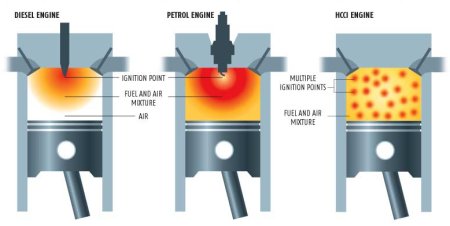Emerging Engine Technology – HCCI – What is it?
Mark | Mar 27, 2009 | Comments 5
Engineers started fiddling around with HCCI (Homogeneous Charge Compression Ignition) in the late 1970s. While the possibilities that HCCI offered were intriguing (especially the fuel economy savings), the technology was too complicated for the time. HCCI research was relegated to the back shelf – until recently when the search for more efficient, eco-friendly gas-sipping engines became priority number one for the auto industry.
HCCI could very well be, if not THE answer to our gas price and oil consumption woes, at least a serious transition from current technology to some sort of future non-fossil fuel engine. What it is requires a little more explanation, and that explanation starts with what HCCI isn’t.

HCCI graphic from New Science magazine 2006.
With conventional gas engines, ignition of the fuel/air mixture is achieved with a spark. With conventional diesel engines, ignition occurs when air in the combustion chamber is heated by compression and the fuel is introduced into this super-heated environment. HCCI is a closer relative of the diesel with one significant difference: the compression heats and ignites a lean, homogenous mix of air and gasoline.
Even more significant than the compression based ignition cycle is the nature of the “burn”: HCCI combustion is low temperature, flame-less, and nearly simultaneous. The net result is a combustion cycle with power equivalent to conventional gas or diesel systems, but with far less fuel consumption…think 15-25% better fuel economy across the board when the technology matures.
Of course, less fuel consumption (and more efficient combustion) also results in fewer emissions. In fact, HCCI nitrous oxide emissions are so low that no catalytic converter is required for HCCI engines. While unburned hydrocarbon and carbon monoxide emissions (due to the low peak temperatures) still need to be treated, current emissions technologies can handle this problem cheaply and easily.
Good fuel economy and low emissions? Sounds like the next big thing…so what”s the catch? What has kept HCCI out of engine compartments for the last 30 years?
The answer is that HCCI is complicated to control. Ignition in conventional engines is easy to control, especially with modern engine management systems. Ignition in HCCI engines requires both chamber temperature and air/fuel mixture controls that react quickly to changing parameters and work seamlessly together. Imagine trying to sustain a nearly continuous explosion in a mayonnaise jar by opening and closing the lid and dipping the jar in cold water, and you have an idea of just how difficult this task is. Until recently, the technology needed to control an HCCI engine simply did not exist.
Today, due in large part to incredible computer advances and ever-improving engine valve control systems, it is now technologically feasible to control HCCI combusion. These systems are still expensive, but “expensive” has become a relative term when compared to the costs of building cars that meet environmental and fuel economy regulations. Detroit”s own General Motors is leading the way with HCCI – last May GM engineers introduced a functional HCCI engine (hybridized with a conventional spark ignition system) in a Saturn Aura.
One of the biggest technological hurdles with HCCI is controlling engine idling. HCCI engines operate in a semi-chaotic state, and maintaing idle is incredibly difficult. GM”s HCCI Saturn Aura concept was a major breakthrough – by coming up with a way to control an HCCI engine during idle, GM has proved the viability of a production HCCI engine. Because of some technical issues and excess noise and vibration, HCCI engines currently operate best in low-load, non-idling situations.
GM managed to overcome some of the limitations of HCCI by adapting a traditional spark ignition mode into the HCCI engine. Spark ignition is still needed to start a cold engine, and in GM”s concept Saturn Aura, the standard spark ignition system kicks in at speeds over 55 mph or during acceleration. Still, even with a hybrid HCCI-spark ignition engine, GM”s concept performed very nicely. The 2.2-liter, four-cylinder psuedo-HCCI engine checks out at a respectable 180 horsepower matched to 170 lb/ft of torque. GM allowed some media to test the concept, and it received rave reviews.
Coming up, we”ll break down the pros and cons of HCCI technology and what it means for the future.
Filed Under: Auto News


OHHHHH AHHHHHH That gets a WOW WHIZ BANG score of 9.3
I still think freedom from pteroleum is way better. Could we say that this is the last hurdle? doubt it.
Jeremy – It is cool, isn’t it?
Ingle – I agree. Still, that might be a while. This seems like a reasonable enhancement for the next few decades while we ween ourselves off of petroleum.
this is not the answer to our energy crisis. the reality is that there has been next to nothing in technology advanvement when it comes to the standard combustion engine. this tech is as old as the hills. check out http://www.massdispensationengine.com. this will donkey kick your brain…an HCCI isnt cool.
josh – I don’t think HCCI is the “answer”, but it’s definitely interesting. So is your site…but to be honest I’m not smart enough to understand it completely.